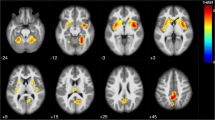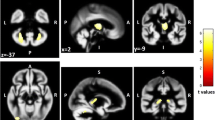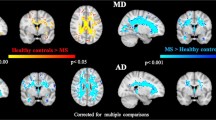Abstract
Information-processing speed (IPS) slowing is a primary cognitive deficit in multiple sclerosis (MS). Basal ganglia, thalamus and neocortex are thought to have a key role for efficient information-processing, yet the specific relative contribution of these structures for MS-related IPS impairment is poorly understood. To determine if basal ganglia and thalamus atrophy independently contribute to visual and auditory IPS impairment in MS, after controlling for the influence of neocortical volume, we enrolled 86 consecutive MS patients and 25 normal controls undergoing 3T brain MRI and neuropsychological testing. Using Sienax and FIRST software, neocortical and deep gray matter (DGM) volumes were calculated. Neuropsychological testing contributed measures of auditory and visual IPS using the Paced Auditory Serial Addition Test (PASAT) and the Symbol Digit Modalities Test (SDMT), respectively. MS patients exhibited significantly slower IPS relative to controls and showed reduction in neocortex, caudate, putamen, globus pallidus, thalamus and nucleus accumbens volume. SDMT and PASAT were significantly correlated with all DGM regions. These effects were mitigated by controlling for the effects of neocortical volume, but all DGM volumes remained significantly correlated with SDMT, putamen (r = 0.409, p < 0.001) and thalamus (r = 0.362, p < 0.001) having the strongest effects, whereas for PASAT, the correlation was significant for putamen (r = 0.313, p < 0.01) but not for thalamus. We confirm the significant role of thalamus atrophy in MS-related IPS slowing and find that putamen atrophy is also a significant contributor to this disorder. These DGM structures have independent, significant roles, after controlling for the influence of neocortex atrophy.

Similar content being viewed by others
References
Denney DR et al (2004) Cognitive impairment in relapsing and primary progressive multiple sclerosis: mostly a matter of speed. J Int Neuropsychol Soc 10(7):948–956
Rao SM, St Aubin-Faubert P, Leo GJ (1989) Information processing speed in patients with multiple sclerosis. J Clin Exp Neuropsychol 11(4):471–477
DeLuca J et al (2004) Is speed of processing or working memory the primary information processing deficit in multiple sclerosis? J Clin Exp Neuropsychol 26(4):550–562
Forn C et al (2008) Information-processing speed is the primary deficit underlying the poor performance of multiple sclerosis patients in the Paced Auditory Serial Addition Test (PASAT). J Clin Exp Neuropsychol 30(7):789–796
Barker-Collo SL (2006) Quality of life in multiple sclerosis: does information-processing speed have an independent effect? Arch Clin Neuropsychol 21(2):167–174
Archibald CJ, Fisk JD (2000) Information processing efficiency in patients with multiple sclerosis. J Clin Exp Neuropsychol 22(5):686–701
Sanfilipo MP et al (2006) Gray and white matter brain atrophy and neuropsychological impairment in multiple sclerosis. Neurology 66(5):685–692
Dineen RA et al (2009) Disconnection as a mechanism for cognitive dysfunction in multiple sclerosis. Brain 132(Pt 1):239–249
Benedict RHB et al (2006) Neocortical atrophy, third ventricular width, and cognitive dysfunction in multiple sclerosis. Arch Neurol 63(9):1301–1306
Amato MP et al (2007) Association of neocortical volume changes with cognitive deterioration in relapsing-remitting multiple sclerosis. Arch Neurol 64(8):1157–1161
Leyden J, Kleinig T (2008) The role of the basal ganglia in data processing. Med Hypotheses 71(1):61–64
Houtchens MK et al (2007) Thalamic atrophy and cognition in multiple sclerosis. Neurol 69(12):1213–1223
Benedict RHB et al (2009) Memory impairment in multiple sclerosis: correlation with deep grey matter and mesial temporal atrophy. J Neurol Neurosurg Psychiatry 80(2):201–206
Polman CH et al (2005) Diagnostic criteria for multiple sclerosis: 2005 revisions to the “McDonald Criteria”. Ann Neurol 58(6):840–846
Zivadinov R et al (2001) Effects of IV methylprednisolone on brain atrophy in relapsing-remitting MS. Neurol 57(7):1239–1247
Zivadinov R et al (2007) Preservation of gray matter volume in multiple sclerosis patients with the Met allele of the rs6265 (Val66Met) SNP of brain-derived neurotrophic factor. Hum Mol Genet 16(22):2659–2668
Patenaude B et al (2008) Improved surface models for FIRST. In: human brain mapping conference
Benedict RHB et al (2002) Minimal neuropsychological assessment of ms patients: a consensus approach. Clin Neuropsychol 16:381–397
Benedict RHB et al (2006) Validity of the minimal assessment of cognitive function in multiple sclerosis (MACFIMS). J Int Neuropsychol Soc 12:549–558
Rao SM (1991) A manual for the brief, repeatable battery of neuropsychological tests in multiple sclerosis. National Multiple Sclerosis Society, New York
Gronwall DM (1977) Paced auditory serial-addition task: a measure of recovery from concussion. Percept Mot Skills 44(2):367–373
Smith A (1982) Symbol digit modalities test: manual. Western Psychological Services, Los Angeles
Chiaravalloti ND, DeLuca J (2008) Cognitive impairment in multiple sclerosis. Lancet Neurol 7(12):1139–1151
Delis DC et al (2000) California verbal learning test manual: second edition, adult version. Psychological Corporation, San Antonio
Benedict RHB (1997) Brief visuospatial memory test-revised: professional manual. Psychological Assessment Resources, Odessa
Benton AL et al (1994) Contributions to neuropsychological assessment. Oxford University Press, New York
Delis DC, Kaplan E, Krammer JH (2001) Delis–Kaplan executive function system. Psychological Corporation, San Antonio
Beck AT, Steer RA, Brown GK (2000) BDI-fast screen for medical patients: manual. Psychological Corporation, San Antonio
Krupp LB et al (1989) The fatigue severity scale. Application to patients with multiple sclerosis and systemic lupus erythematosus. Arch Neurol 46(10):1121–1123
Cifelli A et al (2002) Thalamic neurodegeneration in multiple sclerosis. Ann Neurol 52(5):650–653
Alexander GE, DeLong MR, Strick PL (1986) Parallel organization of functionally segregated circuits linking basal ganglia and cortex. Annu Rev Neurosci 9:357–381
Berman RA, Wurtz RH (2008) Exploring the pulvinar path to visual cortex. Prog Brain Res 171:467–473
Casanova C et al (2001) Higher-order motion processing in the pulvinar. Prog Brain Res 134:71–82
Koziol L, Budding DE (eds) (2010) Subcortical structures and cognition: implications for neuropsychological assessment. Springer, Berlin
Feifel M et al (2004) Inhibitory deficits in ocular motor behavior in adults with attention-defficit/hyperactivity disorder. Biol Psychiatry 56:333–339
Grossman M et al (2002) Information processing speed and sentence comprehension in Parkinson’s disease. Neuropsychology 16(2):174–181
Vieregge P et al (1994) Auditory selective attention is impaired in Parkinson’s disease–event-related evidence from EEG potentials. Brain Res Cogn Brain Res 2(2):117–129
Saft C et al (2008) fMRI reveals altered auditory processing in manifest and premanifest Huntington’s disease. Neuropsychology 46(5):1279–1289
Opitz B, Schroger E, von Cramon DY (2005) Sensory and cognitive mechanisms for preattentive change detection in auditory cortex. Eur J Neurosci 21(2):531–535
Pirko I et al (2007) Gray matter involvement in multiple sclerosis. Neurology 68(9):634–642
Acknowledgments
Supported by National MS Society grant RG4060A3/1.
Conflict of interest
The authors declare that they have no conflict of interest.
Author information
Authors and Affiliations
Corresponding author
Rights and permissions
About this article
Cite this article
Batista, S., Zivadinov, R., Hoogs, M. et al. Basal ganglia, thalamus and neocortical atrophy predicting slowed cognitive processing in multiple sclerosis. J Neurol 259, 139–146 (2012). https://doi.org/10.1007/s00415-011-6147-1
Received:
Accepted:
Published:
Issue Date:
DOI: https://doi.org/10.1007/s00415-011-6147-1




